India, as a civilisational state, firmly believes in the preservation of global heritage for future generations. Along with the conservation of heritage sites within the country, India has also been supporting heritage conservation projects in the Global South. In the 46th Session of the World Heritage Committee at Bharat Mandapam in New Delhi, Prime Minister Narendra Modi highlighted India’s resolve towards the conservation of global heritage. [1] The Archaeological Survey of India (ASI) over a period of time has developed profound expertise in archaeological conservation of cultural heritage sites. This makes India a crucial player in the global effort to protect historical monuments. India has been assisting in the conservation of many heritage sites in Southeast Asian countries like Cambodia, Viet Nam, Myanmar, and Laos with which it shares deep cultural and historical ties. These efforts reflect not only India’s commitment to cultural preservation but also its dedication to fostering international cooperation and cultural diplomacy.
Angkor Wat, a UNESCO World Heritage Site, is one of the most iconic and culturally significant temple complexes in the world. It was constructed by King Suryavarman II in the early 12th century CE. The Hindu-Buddhist temple of Angkor Wat, along with the Bayon, Prasat Preah Khan, Pre Rup, and Ta Prohm, are prime examples of Khmer architecture and are known for their intricate bas-reliefs and towering spires. The entire region of Angkor is therefore, a major site exemplifying cultural, religious, and symbolic values, as well as containing high architectural, archaeological, and artistic significance.
In the 1970s, the Angkor Wat temple complex suffered extensively under the genocidal regime of Pol Pot. During the Khmer Rouge purges, all trained Cambodians who worked on maintaining the site were either executed or expelled. The international support for the conservation of the archaeological sites in Cambodia had also dried out. The Angkor Wat temple was in constant danger of physical damage as it fell in a conflict zone. Recognizing the historical and cultural ties between India and Cambodia, the Indian government, through the ASI, a premier organization under the Ministry of Culture, took a proactive role in the restoration efforts. ASI started the restoration work at Angkor Wat in the 1980s, and it became a testimonial to ASI’s professional expertise in excavation, restoration and maintenance of Hindu, Buddhist and Islamic structures.[2]
Starting in November 1986, [3] an ASI team worked at Angkor Wat for seven years in close cooperation with the Government of Cambodia. In the first phase (1986-1993), ASI focussed on the temple’s main sanctum, which had suffered significant structural damage due to vegetation growth. Extensive steps were taken to remove vegetation growth over the structures in the Angkor Wat complex.[4] The roots of trees compromising the structural integrity of the structures were also removed. The drainage system in and around the structures was improved to avoid water logging. Grouting was used to cover small fissures on the stone surface to prevent further cracking and vegetation growth. ASI conserved the intricate bas-reliefs that adorn the walls of Angkor Wat. These bas-reliefs depict various scenes from Hindu mythology and are considered masterpieces of Khmer art. The project, completed in 1993, was widely acclaimed for its technical excellence and sensitivity to the site's historical context.
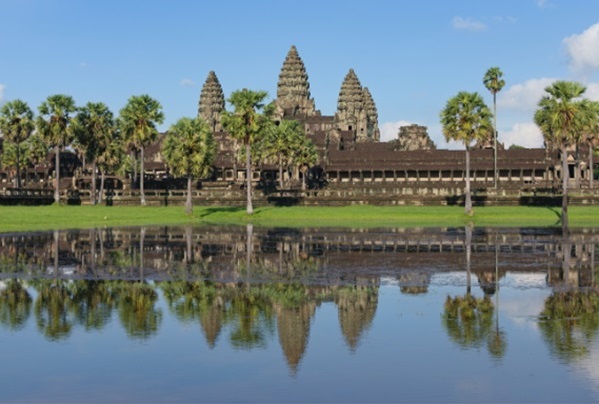
However, India’s presence in Angkor Wat was seen negatively by the western world, which was still reminiscing about the colonial era. The French, who controlled Indo-China, were the most aggrieved. The French had been the colonial masters that had overseen conservation in Angkor for over a century till the conflict in the 1970s forced them out. Thus, the restoration activities of the Indian archaeologist in Angkor were extensively criticized by the western media. Philip Shenon from the New York Times expressed his personal displeasure with the following statement: “Armed with hard brushes and buckets of a solution of ammonia and water, hundreds of unskilled Khmer labourers, working at the Indians' direction, vigorously rub over the delicate stonework as if it were a dirty kitchen floor.” [5] This barrage of criticism did not take into account the challenges the small team of Indian archaeologists faced due to the festering Khmer Rouge insurgency. Despite the dangers, ASI patiently worked along with the Cambodians in the Angkor region.
In 2002, India signed an agreement with Cambodia under the then Prime Minister Atal Bihari Vajpayee [6] for the restoration of the Ta Prohm temple, part of the Angkor Wat complex. Ta Prohm temple was constructed between mid-twelfth century CE and early thirteenth century CE by Khmer King Jayavarman VII. India offered to provide long-term technical assistance, materials and all the necessary funding. By 2012, the ASI, in association with the Authority for the Protection of the Site and Management of the Region of Angkor (also called APSARA), had restored most parts of the Ta Prohm temple complex. [7] To protect the monument from damage from tourists, wooden walkways, platforms, and railings were put in place around the structures. The ‘Hall of Dancers’ at Ta Prohm Temple was renovated by ASI in November 2022. [8] Vice President of India, Jagdeep Dhankhar, attended the inaugural ceremony of the ‘Hall of Dancers’ at Ta Prohm Temple along with External Affairs Minister S. Jaishankar. The Vice President said that he felt like home in Cambodia, which is part of India's "extended family." [9]
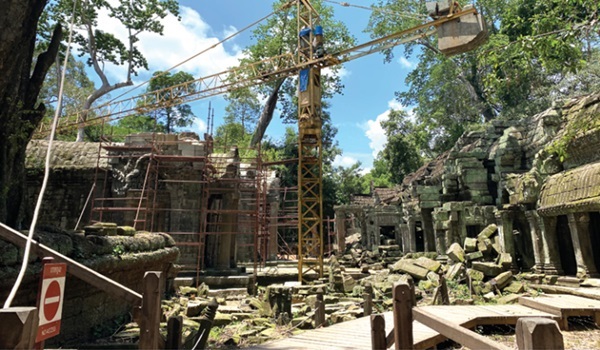
Along with the restoration works in the Angkor region, India also signed a memorandum with the Cambodian government for the restoration of Preah Vihear temple in northern Cambodia in 2018. [10] The temple is dedicated to Lord Shiva and was built during the 11th and 12th centuries. The ASI is working along with other international agencies in the conservation of the UNESCO World Heritage Site in Preah Vihear. [11] These cultural collaborations have strengthened India’s diplomatic ties with Cambodia.
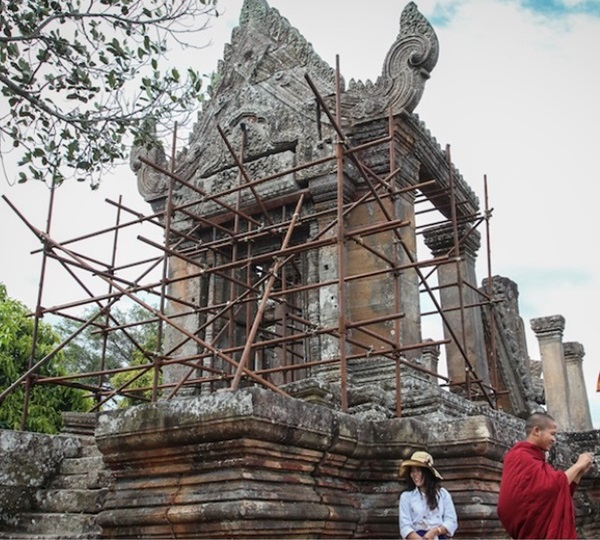
In October 2014, the governments of India and Viet Nam signed a Memorandum of Understanding [12] for conservation and restoration of the partially ruined Shaiva temples in Mỹ Sơn, a UNESCO World Heritage Site in Quang Nam province, Viet Nam. These group of temples are also known as Cham temples and were built between the 4th and 14th centuries by the Kings of Champa, an Indianized kingdom of the Cham people. [13] Mỹ Sơn was a site of religious ceremony for the Kings of Champa and was one of the longest inhabited archaeological sites in Southeast Asia. During the Viet Nam War, US aerial bombing in August 1969 destroyed the structures present at the site. [14]
Post the signing of the 2014 MoU, a technical team of the ASI conducted a survey and prepared detailed estimates and documentation work. Later, ASI was assigned the task of conserving and restoring three blocks of Cham temples in Mỹ Sơn, namely A, H and K temples, in which the work started in 2017. [15] The ASI team, comprising experts in archaeology, architecture, and engineering, undertook meticulous research to understand the original construction techniques and materials used by the Cham builders. This research was crucial in ensuring that the restoration work maintained the authenticity and integrity of the temples. During the restoration work in 2020, ASI discovered a monolithic sandstone Shiva linga from the 9th century CE at Mỹ Sơn. [16] External Affairs Minister S Jaishankar said that the development underscored the “civilisational connect” between the two countries and was also a “great cultural example of India’s development partnership.” [17] ASI completed the conservation and restoration work on the group temples in April 2023. [18]
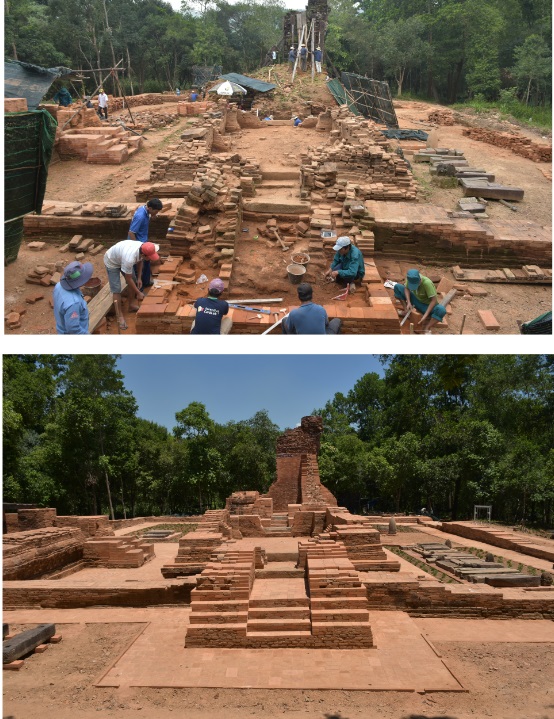
A crucial component of India’s conservation efforts in the Mỹ Sơn region focused on the training and capacity building for Vietnamese conservation professionals. Indian professionals conducted workshops and training sessions, sharing knowledge and techniques in heritage conservation. This capacity-building initiative by India ensures the continuance of preservation work in the region.
Projecting India’s soft power, the current Indian government led by Prime Minister Narendra Modi provided support for the restoration of Buddhist temples, pagodas, and stupas in Bagan (a UNESCO World Heritage Site), in Myanmar. More than 10,000 of these Buddhist structures were built in Bagan between the 11th and 13th centuries, most of which didn’t survive. The existing structures are a testament to Myanmar’s rich historical and religious heritage but are subjected to deterioration due to natural disasters and human-induced causes.
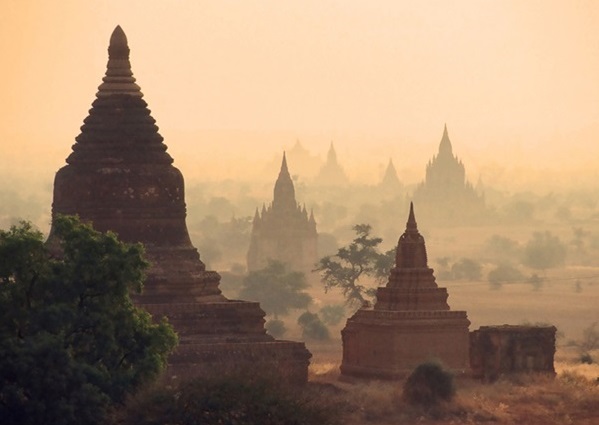
India’s involvement in the conservation of Bagan stupas began in the aftermath of the 2016 earthquake, which caused significant damage to many of the ancient structures. [19] The Union Cabinet of India approved the Memorandum of Understanding (MoU) between India and Myanmar for the conservation of earthquake-damaged pagodas at Bagan, Myanmar. The MoU was signed during the visit of Prime Minister Narendra Modi to Myanmar in September 2017. [20] The restoration work on the damaged pagodas by ASI started in January 2020. The project worth 21 crore Indian rupees was completely funded by the Ministry of External Affairs. [21] In the first phase, ASI had taken up the renovation of 12 pagodas in Bagan.
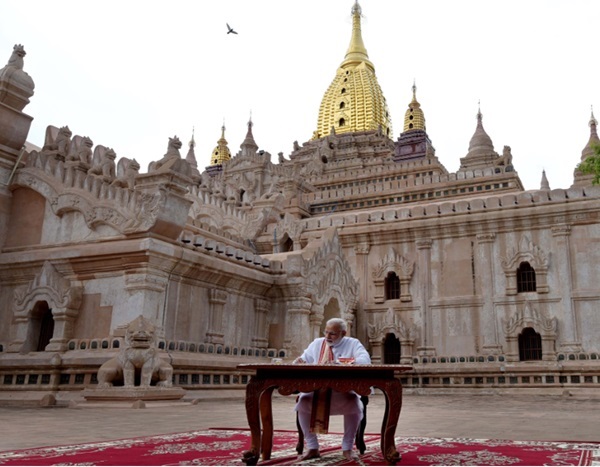
One of the most momentous projects undertaken by the ASI in Bagan was the restoration of the Ananda Temple, a prominent Buddhist pilgrimage site and a masterpiece of Mon architecture, built in the 12th century CE. This temple in Bagan sustained considerable damage during the 2016 earthquake. The restoration cost the Indian government about 1.5 million dollars and was completed in 2018. [22] The restoration of the Ananda Temple has been widely acclaimed for its adherence to historical accuracy and its technical excellence.
India has also significantly contributed to the restoration of the Vat Phou temple in Laos. This ancient Khmer-Hindu temple complex, dating back to the 11th century, is a UNESCO World Heritage site and holds significant historical and architectural value. India's involvement, through financial aid and technical expertise, has been pivotal in addressing the temple's structural challenges and conserving its intricate Khmer architecture. Vat Phou was a part of the Khmer Empire centred on Angkor to the southwest. Vat Phou temple was built by the Khmer royal family as a Shiva temple, but later, with the spread of Buddhism in Southeast Asia, it was converted into a Buddhist temple. However, evidence of it being a Shiva temple is still present in every corner of this temple complex. ASI did the survey work in 2005, and the restoration work started in 2007. In the first phase, the Indian government spent 17 crore Indian rupees. The second phase of restoration work started in 2018, and another 24 crore Indian rupees have already been spent in the restoration work. [23]
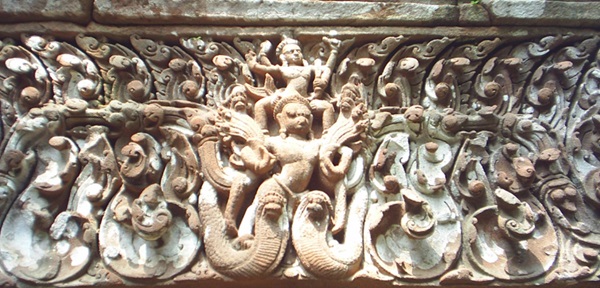
India, as a civilisational state that understands the importance of safeguarding historical sites for future generations, has been extending support for heritage conservation projects to the Global South. It is very clear through the aforementioned instances that India plays a pivotal role in the conservation of cultural heritage in Southeast Asia. These efforts exemplify India’s commitment to the preservation of global heritage. It has also strengthened India's diplomatic ties with Southeast Asian countries and is part of India’s Act East policy.
References
[1] “PM Modi Inaugurates 46th Session of World Heritage Committee at Bharat Mandapam,” NDTV, 21 July 2024.
https://www.ndtv.com/india-news/pm-modi-inaugurates-46th-session-of-world-heritage-committee-at-bharat-mandapam-6156010
[2] “Etched on stone,” The Telegraph Online, 14 August 2020.
https://www.telegraphindia.com/opinion/etched-on-stone-archaeology-and-geopolitics/cid/1789084
[3] Narasimhaiah, B., Angkor Vat: India’s Contribution in Conservation 1986-1993, New Delhi, 1994, page 9.
[4] Narasimhaiah, B., Angkor Vat: India’s Contribution in Conservation 1986-1993, New Delhi, 1994, page 15.
[5] Shenon, Philip. “Washing Buddha's Face,” The New York Times Magazine, 21 June 1992.
https://www.nytimes.com/1992/06/21/magazine/washing-buddha-s-face.html
[6] D’Monte, Darryl. “India pledges support for Angkor Wat restoration,” The Art Newspaper, 1 May 2004.
https://www.theartnewspaper.com/2004/05/01/india-pledges-support-for-angkor-wat-restoration
[7] Subramanian, T. S., “ASI rebuilding the glory of Buddhist complex in Cambodia,” The Hindu, 30 July 2012.
https://www.thehindu.com/features/friday-review/history-and-culture/asi-rebuilding-the-glory-of-buddhist-complex-in-cambodia/article3700248.ece
[8] Sokny, Chea. “Ta Prohm’s ‘Hall of Dancers’ set for tourists,” The Phnom Penh Post, 15 November 2022.
https://www.phnompenhpost.com/travel/ta-prohms-hall-dancers-set-tourists
[9] “We are in our extended family, Vice President Dhankhar says in Cambodia,” The Hindu, 13 November 2022.
https://www.thehindu.com/news/national/we-are-in-our-extended-family-vice-president-dhankhar-says-in-cambodia/article66132292.ece
[10] “India to help Cambodia renovate Lord Shiva temple,” The Times of India, 29 August 2018.
https://timesofindia.indiatimes.com/india/india-to-help-cambodia-renovate-lord-shiva-temple/articleshow/65593992.cms
[11] “Meeting reviews conservation progress of Preah Vihear, Koh Ker temples,” Khmer Times, 22 March 2024.
https://www.khmertimeskh.com/501460360/meeting-reviews-conservation-progress-of-preah-vihear-koh-ker-temples/
[12] Memorandum of Understanding between the Government of the Republic of India and the Government of the Socialist Republic of Viet Nam for the Conservation and Restoration of the World Heritage Site of Mỹ Sơn, Quang Nam Province, Viet Nam
https://www.mea.gov.in/Portal/LegalTreatiesDoc/VN14B1842.pdf
[13] Andrew David Hardy, Mauro Cucarzi, Patrizia Zolese, Champa and the Archaeology of Mỹ Sơn 2009
[14] Mỹ Sơn Temple District
https://www.wmf.org/project/my-son-temple-district#:~:text=During%20the%20Vietnam%20War%2C%20My,site%20and%20damaged%20several%20others.
[15] Conservation and Restoration works of A, H & K Group of Temple in World Heritage Site of Mỹ Sơn Sanctuary, Quang Province, Vietnam, Archaeological Survey of India Report, page 5.
[16] “Archaeological Survey of India discovers 9th century sandstone Shiva linga in Vietnam,” The Print, 27 May 2020.https://theprint.in/india/archaeological-survey-of-india-discovers-9th-century-sandstone-shiva-linga-in-vietnam/430366/
[17] “ASI unearths 9th century Shiv Linga during restoration of temple complex in Vietnam,” 27 May 2020.
https://www.hindustantimes.com/india-news/asi-unearths-9th-century-shiv-linga-during-restoration-of-temple-complex-in-vietnam/story-rSzk6fCRSPvejJ6PyZM4AP.html
[18] “Press Release on Completion of conservation and restoration of A, H & K temples at My Son Sanctuary.” Embassy of India, Hanoi, Vietnam, 11 April 2023.
https://www.indembassyhanoi.gov.in/news_letter_detail/?id=205#:~:text=In%201999%2C%20World%20Heritage%20Committee,at%20My%20Son%20in%202014.
[19] “Myanmar earthquake: Images from Bagan historic sites,” BBC News, 25 August 2016.
https://www.bbc.com/news/world-asia-37183943
[20] “Cabinet approves MoU with Myanmar for the Conservation of Earthquake-Damaged Pagodas at Bagan,” Business Standard, 30 August 2017.
https://www.business-standard.com/article/news-cm/cabinet-approves-mou-with-myanmar-for-the-conservation-of-earthquake-damaged-pagodas-at-bagan-117083000647_1.html
[21] “India funds restoration of Pagodas in Myanmar,” The Times of India, 5 October 2020.
https://timesofindia.indiatimes.com/india/india-funds-restoration-of-pagodas-in-myanmar/articleshow/78494396.cms
[22] Whitaker, Justin. “Indian Archaeologists Resume Restoration of Pagodas in Bagan, Myanmar after COVID-19 Delay,” Buddhist Door Global, 8 October 2020.
https://www.buddhistdoor.net/news/indian-archaeologists-resume-restoration-of-pagodas-in-bagan-myanmar-after-covid-19-delay/
[23] “Preserving Hindu Heritage: ASI’s restoration efforts at Vat Phou temple in Laos,” Organiser: Voice of the Nation, 5 July 2024.
https://organiser.org/2024/07/05/245876/world/preserving-hindu-heritage-asis-restoration-efforts-at-vat-phou-temple-in-laos/
(The paper is the author’s individual scholastic articulation. The author certifies that the article/paper is original in content, unpublished and it has not been submitted for publication/web upload elsewhere, and that the facts and figures quoted are duly referenced, as needed, and are believed to be correct). (The paper does not necessarily represent the organisational stance... More >>
Image Source: https://mgc.gov.in/portfolio/view/14










Post new comment